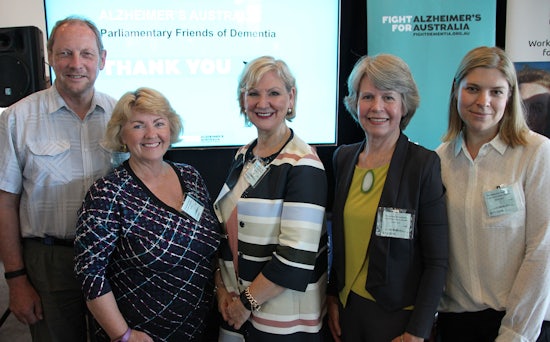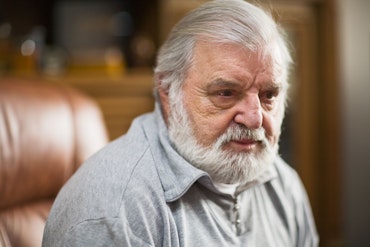New resource a wealth of information for those living with dementia
From what questions to ask healthcare professionals and accessing services to living well rehabilitation, support for carers and advanced care planning, a comprehensive new booklet has a wealth of information for people living with dementia, their carers and families.

Consumers Conny and Brian Gard, Alzheimer’s Australia National CEO Maree McCabe, Dr Jane Thompson (NHMRC National Institute or Dementia Research) and Dr Kate Laver (NHMRC CDPC)
Processes such as what tests a GP will perform are clearly explained, the expected level of care and what to do if this level of care isn’t met is also included.
The Consumer Companion Guide, ‘Diagnosis, treatment and care for people with dementia’ has been developed by people living with dementia, carers, researchers and clinicians from the National Health and Medical Research Council’s Cognitive Decline Partnership Centre (NHMRC CDPD).
It was launched in partnership with Alzheimer’s Australia at the recent Parliamentary Friends of Dementia event, and Alzheimer’s Australia National President Professor Graeme Samuel AC says consumers played a key role in the Consumer Companion Guide development to ensure the document is relevant to the needs of people living with dementia and their carers.
“These guidelines are an example of the significant impact that can be achieved when consumers partner with clinicians and researchers,” Professor Graeme Samuel AC said.
It is believed to be the first comprehensive guide of its kind and is designed to complement the Clinical Practice Guidelines and Principles of Care for People with Dementia, 2016 which were launched in March this year.
Dr Kate Laver lead coordinator of the Consumer Companion Guide also worked on the Clinical Guidelines. She says this new guide also aims to ensure information is more accessible to those who need it most, regardless of their varied levels of health literacy.
One of the consumer representatives on the collaborative working group cared for her husband who died of Alzheimer’s disease in 2007.
“There were no Australian clinical practice guidelines for dementia when I was caring for my husband, let alone versions summarising the information in an accessible form. I know I would have benefited enormously from having had access to such an up-to-date summary of the best available evidence,” Dr Jane Thompson says.
She hopes it [the guide] will improve the quality of care for those people currently living with dementia, their carers and families.
The link to both the Clinical Practice Guidelines and the new Consumer Guide can be found on the Alzheimer’s Australia website.











![The new Aged Care Act exposure draft is slated for release in December of 2023, but advocates hope to see it rolled out on January 1, 2024. [Source: Shutterstock]](https://agedcareguide-assets.imgix.net/news/articles/wp/agedcareact__0811.jpg?fm=pjpg&w=520&format=auto&q=65)












Comments